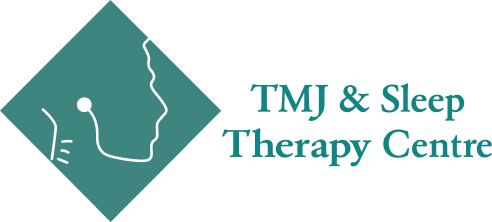Mouth breathing affects far more than the way you breathe. It changes jaw position, strains the muscles that control chewing and posture, and disrupts sleep quality. This guide explains the most common causes of mouth breathing and how it contributes to TMJ pain, headaches, fatigue, and poor sleep in adults and children throughout South Bend, Granger, and Fort Wayne.
Mouth breathing is far more common than most people realize. Many adults and children breathe through their mouth without noticing, especially during sleep. What seems like a simple habit can actually signal an underlying airway issue, tongue posture problem, or chronic nasal obstruction. Over time, mouth breathing affects the jaw, facial muscles, posture, and overall health, often contributing to TMJ disorders, headaches, and sleep difficulties.
At TMJ and Sleep Indiana, we frequently see patients who have been treated for facial pain or headaches for years without anyone identifying that mouth breathing is playing a crucial role. Understanding why mouth breathing happens and how it affects the body can help you take the right steps toward relief.
What Causes Mouth Breathing
Mouth breathing occurs when the nose cannot properly support airflow or when the structures of the mouth and throat encourage air to enter through the mouth instead of the nose. Some of the most common causes include nasal congestion, allergies, chronic sinus inflammation, deviated septum, enlarged tonsils or adenoids, and tongue tie that restricts natural tongue posture.
Poor tongue posture is a major contributor. The tongue should rest gently against the roof of the mouth. When it falls low or forward due to habit or airway restriction, the mouth naturally opens. Many people also develop mouth breathing during sleep when the muscles relax, especially if they clench or grind their teeth.
Stress can worsen mouth breathing by creating tension that alters the way the jaw and tongue rest. In children, narrow palates, crowded teeth, and underdeveloped nasal passages often contribute. In adults, chronic allergies, sleep apnea, and inflammation are frequent causes.
Regardless of the reason, the result is the same: air bypasses the nose and enters through the mouth, altering the entire structure and function of the face and jaw.
How Mouth Breathing Affects Jaw Position and Muscle Function
Breathing through the mouth changes the position of the jaw. The lower jaw tends to drop downward and backward, creating strain in the muscles that stabilize the TMJ. When the mouth stays slightly open for long periods of time, the jaw muscles work overtime to support this unnatural position.
This leads to tightness, fatigue, and overuse of the chewing and facial muscles. Over time, jaw alignment can shift, making chewing, speaking, and even resting uncomfortable. These changes eventually contribute to TMJ disorders.
Because the TMJ is connected to nerves and muscles in the neck, shoulders, and head, chronic mouth breathing can trigger pain patterns that extend far beyond the jaw.
The Connection Between Mouth Breathing and TMJ Disorders
Many patients with TMJ disorders unknowingly breathe through their mouth. When the jaw remains open or strained, the TMJ becomes stressed and the muscles surrounding it tighten. This tension creates a cycle of discomfort that can lead to ongoing jaw pain, clicking, popping, or difficulty opening the mouth.
Clenching and grinding are extremely common in mouth breathers. When the airway narrows during sleep, the body uses jaw tension to create stability, leading to nighttime clenching. This constant pressure inflames the TMJ and surrounding muscles, making mornings particularly difficult for many patients.
Mouth breathing also contributes to poor tongue posture, which affects the bite, facial structure, and the way the jaw develops in children. When left unaddressed, the airway and TMJ issues often get worse over time.
Why Mouth Breathing Causes Headaches and Facial Pain
Headaches are one of the most overlooked symptoms of mouth breathing. When you breathe through your mouth, the tongue sits low, the jaw moves backward, and the head often shifts forward to compensate. This creates tension in the neck, scalp, and facial muscles.
These muscles overwork to support the head and jaw, which leads to tension headaches, pressure in the temples, and facial pain. Poor oxygen flow during sleep can also contribute to morning headaches and fatigue.
This combination of muscle tension, poor alignment, and sleep disruption is why so many chronic headache patients also have airway and breathing concerns that have never been addressed.
How Mouth Breathing Impacts Sleep Quality
During sleep, the body relies on stable nasal breathing to support oxygen levels and restore the brain and muscles. Mouth breathing bypasses the natural filtration and humidification system of the nose and leads to fragmented sleep.
Common sleep issues caused or worsened by mouth breathing include snoring, nighttime clenching and grinding, frequent waking, dry mouth, and morning soreness in the jaw or face. In both adults and children, mouth breathing increases the risk of obstructive sleep apnea.
Children who breathe through their mouth may also struggle with attention, behavior, and focus due to poor sleep quality and reduced oxygenation. Adults may experience brain fog, daytime fatigue, or unrested sleep even after a full night in bed.
Signs You May Be a Mouth Breather
Many people mouth breathe without realizing it. Here are common signs:
- Dry mouth
- Chapped lips or drooling during sleep
- Dark under-eye circles
- Morning headaches
- Bad breath
- Narrow or crowded teeth
- Daytime fatigue
- Head and neck tension
- Difficulty breathing through the nose
In children, mouth breathing may also contribute to poor posture, hyperactivity, bedwetting, or difficulty staying focused in school.
Recognizing the early signs allows you to seek treatment before symptoms worsen.
Diagnosing Mouth Breathing in Adults and Children
A proper diagnosis begins with an airway-focused evaluation. This may include reviewing symptoms, assessing tongue posture, evaluating nasal breathing, examining jaw function, and screening for sleep-disordered breathing.
Imaging may be used to understand the airway space and evaluate the TMJ. For children, assessing facial growth and palate development is especially important, since addressing airway problems early can prevent lifelong issues.
At TMJ and Sleep Indiana, we take a comprehensive approach, looking at the airway, tongue posture, jaw position, and breathing patterns together so nothing is overlooked.
Treatment Options That Support Better Breathing and Jaw Function
Because mouth breathing has multiple causes, treatment often involves a combination of approaches. Based on your evaluation, your treatment plan may include myofunctional therapy to retrain tongue posture and support nasal breathing, custom oral appliances to improve jaw position and reduce nighttime clenching, laser tongue tie release when a restricted tongue is contributing to mouth breathing, and collaboration with ENT specialists when nasal obstruction is present.
Sleep apnea treatment may also be recommended for adults who show signs of airway collapse during sleep. For children, addressing palate development and airway growth can make a significant difference in long term health.
The goal is always to restore healthy nasal breathing, reduce strain on the jaw and facial muscles, and improve sleep quality.
Lifestyle Tips to Support Better Nasal Breathing
Simple daily changes can make a noticeable difference in symptoms. These include practicing tongue posture awareness, using nasal saline rinses or humidifiers during allergy season, avoiding mouth breathing during physical activity, improving sleep posture, and incorporating gentle breathing exercises to encourage nasal airflow.
These steps support the body’s ability to maintain healthy breathing patterns both day and night.
Why Early Treatment Matters, Especially for Children
For children, mouth breathing affects facial growth, tooth alignment, sleep quality, and overall development. Addressing airway issues early can prevent a lifetime of TMJ symptoms and sleep disorders.
For adults, correcting mouth breathing can reduce pain, improve sleep, decrease headaches, and enhance overall wellness. Early treatment helps protect the TMJ and prevents long term complications.
Next Steps for Patients in South Bend, Granger, and Fort Wayne
If you or your child shows signs of mouth breathing, early evaluation is important. Identifying the cause allows for targeted, effective treatment that supports better breathing, jaw comfort, and long term health.
If you experience TMJ pain, headaches, fatigue, or difficulty breathing through your nose, schedule an airway and TMJ consultation with TMJ and Sleep Indiana. Our team will help you uncover the root cause and guide you toward lasting relief.





